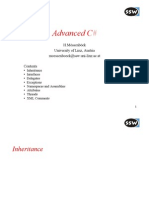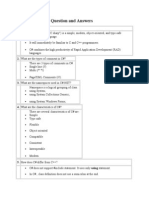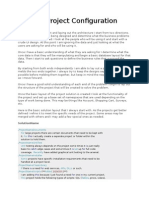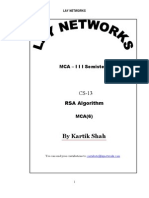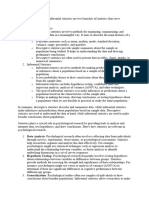C# Coding Style Guide
Uploaded by
AdarshC# Coding Style Guide
Uploaded by
AdarshTechnotes, HowTo Series
C♯ Coding Style Guide
Version 0.4
by Mike Krüger, mike@icsharpcode.net
Contents
1 About the C♯ Coding Style Guide............................................................1
2 File Organization.................................................................................1
3 Indentation........................................................................................2
4 Comments..........................................................................................3
5 Declarations.......................................................................................4
6 Statements........................................................................................5
7 White Space.......................................................................................7
8 Naming Conventions............................................................................9
9 Programming Practices.......................................................................11
10 Code Examples................................................................................12
1 About the C♯ Coding Style Guide
This document may be read as a guide to writing robust and reliable programs. It
focuses on programs written in C♯, but many of the rules and principles are useful
even if you write in another programming language.
2 File Organization
2.1 C♯ Sourcefiles
Keep your classes/files short, don't exceed 2000 LOC, divide your code up, make
structures clearer. Put every class in a separate file and name the file like the class
name (with .cs as extension of course). This convention makes things much easier.
2.2 Directory Layout
Create a directory for every namespace. (For MyProject.TestSuite.TestTier use
© Mike Krüger 2002 1
MyProject/TestSuite/TestTier as the path, do not use the namespace name with
dots.) This makes it easier to map namespaces to the directory layout.
3 Indentation
3.1 Wrapping Lines
When an expression will not fit on a single line, break it up according to these general
principles:
Break after a comma.
Break after an operator.
Prefer higher-level breaks to lower-level breaks.
Align the new line with the beginning of the expression at the same
level on the previous line
Example of breaking up method calls:
longMethodCall(expr1, expr2,
expr3, expr4, expr5);
Examples of breaking an arithmetic expression:
PREFER:
var = a * b / (c - g + f) +
4 * z;
BAD STYLE – AVOID:
var = a * b / (c - g +
f) + 4 * z;
The first is preferred, since the break occurs outside the paranthesized
expression (higher level rule). Note that you indent with tabs to the
indentation level and then with spaces to the breaking position in our
example this would be:
> var = a * b / (c - g + f) +
> ......4 * z;
Where '>' are tab chars and '.' are spaces. (the spaces after the tab char are the
indent with of the tab). A good coding practice is to make the tab and space chars
visible in the editor which is used.
3.2 White Spaces
An indentation standard using spaces never was achieved. Some people like 2 spaces,
some prefer 4 and others die for 8, or even more spaces. Better use tabs. Tab
characters have some advantages:
Everyone can set their own preferred indentation level
It is only 1 character and not 2, 4, 8 … therefore it will reduce typing
(even with smart indenting you have to set the indentation manually
© Mike Krüger 2002 2
sometimes, or take it back or whatever)
If you want to increase the indentation (or decrease), mark one block
and increase the indent level with Tab with Shift-Tab you decrease the
indentation. This is true for almost any text editor.
Here, we define the Tab as the standard indentation character.
Don't use spaces for indentation - use tabs!
4 Comments
4.1 Block Comments
Block comments should usually be avoided. For descriptions use of the /// comments
to give C♯ standard descriptions is recommended. When you wish to use block
comments you should use the following style :
/* Line 1
* Line 2
* Line 3
*/
As this will set off the block visually from code for the (human) reader. Alternatively
you might use this old fashioned C style for single line comments, even though it is
not recommended. In case you use this style, a line break should follow the
comment, as it is hard to see code proceeded by comments in the same line:
/* blah blah blah */
Block comments may be useful in rare cases, refer to the TechNote
'The fine Art of Commenting' for an example. Generally block
comments are useful for comment out large sections of code.
4.2 Single Line Comments
You should use the // comment style to "comment out" code (SharpDevelop has a key
for it, Alt+/) . It may be used for commenting sections of code too.
Single line comments must be indented to the indent level when they are used for
code documentation. Commented out code should be commented out in the first line
to enhance the visibility of commented out code.
A rule of thumb says that generally, the length of a comment should not exceed the
length of the code explained by too much, as this is an indication of too complicated,
potentially buggy, code.
4.3 Documentation Comments
In the .net framework, Microsoft has introduced a documentation generation system
based on XML comments. These comments are formally single line C♯ comments
© Mike Krüger 2002 3
containing XML tags. They follow this pattern for single line comments:
/// <summary>
/// This class...
/// </summary>
Multiline XML comments follow this pattern:
/// <exception cref=”BogusException”>
/// This exception gets thrown as soon as a
/// Bogus flag gets set.
/// </exception>
All lines must be preceded by three slashes to be accepted as XML comment lines.
Tags fall into two categories:
• Documentation items
• Formatting/Referencing
The first category contains tags like <summary>, <param> or <exception>.
These represent items that represent the elements of a program's API which must be
documented for the program to be useful to other programmers. These tags usually
have attributes such as name or cref as demonstrated in the multi line example
above. These attributes are checked by the compiler, so they should be valid.
The latter category governs the layout of the documentation, using tags such as
<code>, <list> or <para>.
Documentation can then be generated using the 'documentation' item in the ♯develop
'build' menu. The documentation generated is in HTMLHelp format.
For a fuller explanation of XML comments see the Microsoft .net framework SDK
documentation. For information on commenting best practice and further issues
related to commenting, see the TechNote 'The fine Art of Commenting'.
5 Declarations
5.1 Number of Declarations per Line
One declaration per line is recommended since it encourages commenting1. In other
words,
int level; // indentation level
int size; // size of table
Do not put more than one variable or variables of different types on the same line
when declaring them. Example:
int a, b; //What is 'a'? What does 'b' stand for?
The above example also demonstrates the drawbacks of non-obvious variable names.
Be clear when naming variables.
1 Of course, using self-explanatory variable names such as indentLevel make these comments obsolete.
© Mike Krüger 2002 4
5.2 Initialization
Try to initialize local variables as soon as they are declared. For example:
string name = myObject.Name;
or
int val = time.Hours;
Note: If you initialize a dialog try to use the using statement:
using (OpenFileDialog openFileDialog = new OpenFileDialog()) {
...
}
5.3 Class, Interface and Namespace Declarations
When coding C♯ classes, interfaces and namespaces , the following formatting rules
should be followed:
• The opening brace "{" appears in the next line after the declaration
statement.
• The closing brace "}" starts a line by itself indented to match its
corresponding opening brace.
For example:
class MySample : MyClass, IMyInterface
{
int myInt;
namespace MyNamespace
{
// namespace contents
}
© Mike Krüger 2002 5
For a brace placement example look at section 10.1.
5.4 Method Declarations
For method declarations the class bracket placement rules should be applied and
you should use no space between a method name and the parenthesis "(" starting
its parameter list.
For example:
public MySample(int myInt)
{
this.myInt = myInt ;
}
void Inc()
{
++myInt;
}
5.4 Property, Indexer and Event Declarations
For properties, indexers and events you should NOT put any brace at it's own line
expect the final closing brace "}".
For example:
public int Amount {
get {
...
}
set {
...
}
}
public this[string index] {
get;
set;
}
public EventHandler MyEvent {
add {
...
}
remove {
...
}
}
© Mike Krüger 2002 6
6.1 Simple Statements
Each line should contain only one statement.
6.2 Return Statements
A return statement should not use outer most parentheses.
Don't use : return (n * (n + 1) / 2);
use : return n * (n + 1) / 2;
6.3 If, if-else, if else-if else Statements
if, if-else and if else-if else statements should look like this:
if (condition) {
DoSomething();
...
}
if (condition) {
DoSomething();
...
} else {
DoSomethingOther();
...
}
if (condition) {
DoSomething();
...
} else if (condition) {
DoSomethingOther();
...
} else {
DoSomethingOtherAgain();
...
}
6.4 For / Foreach Statements
A for statement should have following form :
for (int i = 0; i < 5; ++i) {
...
}
or single lined (consider using a while statement instead) :
for (initialization; condition; update) ;
A foreach should look like :
© Mike Krüger 2002 7
foreach (int i in IntList) {
...
}
Note: Generally use brackets even if there is only one statement in the loop.
6.5 While/do-while Statements
A while statement should be written as follows:
while (condition) {
...
}
An empty while should have the following form:
while (condition) ;
A do-while statement should have the following form:
do {
...
} while (condition);
6.6 Switch Statements
A switch statement should be of following form:
switch (condition) {
case A:
...
break;
case B:
...
break;
default:
...
break;
}
6.7 Try-catch Statements
A try-catch statement should follow this form:
try {
...
} catch (Exception) {}
or
try {
© Mike Krüger 2002 8
...
} catch (Exception e) {
...
}
or
try {
...
} catch (Exception e) {
...
} finally {
...
}
7 White Space
7.1 Blank Lines
Blank lines improve readability. They set off blocks of code which are in themselves
logically related.
Two blank lines should always be used between:
Logical sections of a source file
Class and interface definitions (try one class/interface per file to prevent this case)
One blank line should always be used between:
Methods
Properties
Local variables in a method and its first statement
Logical sections inside a method to improve readability
Note that you should always indent blank lines to the correct indent level instead of
leaving them blank or more worse using another indentation level. This insertion of
new statements in these lines much easier.
7.2 Inter-term spacing
There should be a single space after a comma or a semicolon, for example:
TestMethod(a, b, c); don't use : TestMethod(a,b,c)
or
TestMethod( a, b, c );
Single spaces surround operators (except unary operators like increment or logical
not), example:
a = b; // don't use a=b;
for (int i = 0; i < 10; ++i) // don't use for (int i=0; i<10; ++i)
// or
© Mike Krüger 2002 9
// for(int i=0;i<10;++i)
7.3 Table like formatting
A logical block of lines should be formatted as a table:
string name = "Mr. Ed";
int myValue = 5;
Test aTest = Test.TestYou;
Use spaces for the table like formatting and not tabs because the table formatting
may look strange in special tab intent levels.
© Mike Krüger 2002 10
8 Naming Conventions
8.1 Capitalization Styles
8.1.1 Pascal Casing
This convention capitalizes the first character of each word (as in TestCounter).
8.1.2 Camel Casing
This convention capitalizes the first character of each word except the first one. E.g.
testCounter.
8.1.3 Upper case
Only use all upper case for identifiers if it consists of an abbreviation which is one or
two characters long, identifiers of three or more characters should use Pascal Casing
instead. For Example:
public class Math
{
public const PI = ...
public const E = ...
public const feigenBaumNumber = ...
}
8.2. Naming Guidelines
Generally the use of underscore characters inside names and naming according to the
guidelines for Hungarian notation are considered bad practice.
Hungarian notation is a defined set of pre and postfixes which are applied to names to
reflect the type of the variable. This style of naming was widely used in early Windows
programming, but now is obsolete or at least should be considered deprecated. Using
Hungarian notation is not allowed if you follow this guide.
And remember: a good variable name describes the semantic not the type.
An exception to this rule is GUI code. All fields and variable names that contain GUI
elements like button should be postfixed with their type name without abbreviations.
For example:
System.Windows.Forms.Button cancelButton;
System.Windows.Forms.TextBox nameTextBox;
8.2.1 Class Naming Guidelines
Class names must be nouns or noun phrases.
UsePascal Casing see 8.1.1
Do not use any class prefix
8.2.2 Interface Naming Guidelines
Name interfaces with nouns or noun phrases or adjectives describing behavior.
(Example IComponent or IEnumberable)
© Mike Krüger 2002 11
Use Pascal Casing (see 8.1.1)
Use I as prefix for the name, it is followed by a capital letter (first char of the
interface name)
8.2.3 Enum Naming Guidelines
Use Pascal Casing for enum value names and enum type names
Don’t prefix (or suffix) a enum type or enum values
Use singular names for enums
Use plural name for bit fields.
8.2.4 ReadOnly and Const Field Names
Name static fields with nouns, noun phrases or abbreviations for nouns
Use Pascal Casing (see 8.1.1)
8.2.5 Parameter/non const field Names
Do use descriptive names, which should be enough to determine the variable
meaning and it’s type. But prefer a name that’s based on the parameter’s meaning.
Use Camel Casing (see 8.1.2)
8.2.6 Variable Names
Counting variables are preferably called i, j, k, l, m, n when used in 'trivial'
counting loops. (see 10.2 for an example on more intelligent naming for global
counters etc.)
Prefer using prefixes for boolean variables like Is, Has or Can. Generally you
should give boolean variables names that imply true or false (for example:
fileFound, done, success or with is prefixes: isFileFound, isDone, isSuccess
but don't try IsName that doesn't make sense at all).
Use Camel Casing (see 8.1.2)
8.2.7 Method Names
Name methods with verbs or verb phrases.
Use Pascal Casing (see 8.1.2)
8.2.8 Property Names
Name properties using nouns or noun phrases
Use Pascal Casing (see 8.1.2)
Consider naming a property with the same name as it’s type
8.2.9 Event Names
Name event handlers with the EventHandler suffix.
Use two parameters named sender and e
Use Pascal Casing (see 8.1.1)
Name event argument classes with the EventArgs suffix.
Name event names that have a concept of pre and post using the present and past
tense.
Consider naming events using a verb.
8.2.10 Capitalization summary
© Mike Krüger 2002 12
Type Case Notes
Class / Struct Pascal
Casing
Interface Pascal Starts with I
Casing
Enum values Pascal
Casing
Enum type Pascal
Casing
Events Pascal
Casing
Exception class Pascal End with Exception
Casing
public Fields Pascal
Casing
Methods Pascal
Casing
Namespace Pascal
Casing
Property Pascal
Casing
Protected/private Fields Camel
Casing
Parameters Camel
Casing
9 Programming Practices
9.1 Visibility
Do not make any instance or class variable public, make them private. Try to avoid
the “private” keyword this is the standard modifier and all C# programmers should
know that therefore just write nothing.
Use properties for class variables instead. You may use public static fields (or const)
as an exception to this rule, but be careful with it.
9.2 No 'magic' Numbers
Don’t use magic numbers, i.e. place constant numerical values directly into the source
code. Replacing these later on in case of changes (say, your application can now
handle 3540 users instead of the 427 hardcoded into your code in 50 lines scattered
troughout your 25000 LOC) is error-prone and unproductive. Instead declare a const
variable which contains the number :
public class MyMath
© Mike Krüger 2002 13
{
public const double PI = 3.14159...
}
© Mike Krüger 2002 14
10 Code Examples
10.1 Brace placement example
namespace ShowMeTheBracket
{
public enum Test {
TestMe,
TestYou
}
public class TestMeClass
{
Test test;
public Test Test {
get {
return test;
}
set {
test = value;
}
}
void DoSomething()
{
if (test == Test.TestMe) {
//...stuff gets done
} else {
//...other stuff gets done
}
}
}
}
Brackets should begin on a new line only after:
• Namespace declarations (note that this is new in version 0.3 and was different in
0.2)
• Class/Interface/Struct declarations
• Method declarations
© Mike Krüger 2002 15
10.2 Variable naming example
instead of :
for (int i = 1; i < num; ++i) {
meetsCriteria[i] = true;
}
for (int i = 2; i < num / 2; ++i) {
int j = i + i;
while (j <= num) {
meetsCriteria[j] = false;
j += i;
}
}
for (int i = 0; i < num; ++i) {
if (meetsCriteria[i]) {
Console.WriteLine(i + " meets criteria");
}
}
try intelligent naming :
for (int primeCandidate = 1; primeCandidate < num; ++primeCandidate)
{
isPrime[primeCandidate] = true;
}
for (int factor = 2; factor < num / 2; ++factor) {
int factorableNumber = factor + factor;
while (factorableNumber <= num) {
isPrime[factorableNumber] = false;
factorableNumber += factor;
}
}
for (int primeCandidate = 0; primeCandidate < num; ++primeCandidate) {
if (isPrime[primeCandidate]) {
Console.WriteLine(primeCandidate + " is prime.");
}
}
Note: Indexer variables generally should be called i, j, k etc. But in
cases like this, it may make sense to reconsider this rule. In general, when
the same counters or indexers are reused, give them meaningful names.
© Mike Krüger 2002 16
You might also like
- C#. A Detailed Approach To Practical Coding - Nathan Clark - (E-Pub - Me)No ratings yetC#. A Detailed Approach To Practical Coding - Nathan Clark - (E-Pub - Me)144 pages
- Eap A1 Unit 1 Quiz - Answer Sheet: Grammar B /5No ratings yetEap A1 Unit 1 Quiz - Answer Sheet: Grammar B /53 pages
- Fight For 15 Case Study Jwjprotestpic-BetterNo ratings yetFight For 15 Case Study Jwjprotestpic-Better3 pages
- Chapter 8 - Object Oriented Programming in C#No ratings yetChapter 8 - Object Oriented Programming in C#16 pages
- Introduction To Object Oriented Programming Concepts (OOPS) in C#.Net - ASP - Net, C#.NET, VBNo ratings yetIntroduction To Object Oriented Programming Concepts (OOPS) in C#.Net - ASP - Net, C#.NET, VB9 pages
- SFML Essentials: Getting Started with Game Development: SFML FundamentalsFrom EverandSFML Essentials: Getting Started with Game Development: SFML FundamentalsNo ratings yet
- Learn C Programming through Nursery Rhymes and Fairy Tales: Classic Stories Translated into C ProgramsFrom EverandLearn C Programming through Nursery Rhymes and Fairy Tales: Classic Stories Translated into C ProgramsNo ratings yet
- C# Programming Illustrated Guide For Beginners & Intermediates: The Future Is Here! Learning By Doing ApproachFrom EverandC# Programming Illustrated Guide For Beginners & Intermediates: The Future Is Here! Learning By Doing ApproachNo ratings yet
- DirectX Demystified: A Comprehensive Guide to Game Development EssentialsFrom EverandDirectX Demystified: A Comprehensive Guide to Game Development EssentialsNo ratings yet
- Embedded Systems Programming with C: Writing Code for MicrocontrollersFrom EverandEmbedded Systems Programming with C: Writing Code for MicrocontrollersNo ratings yet
- Mastering SFML: Building Interactive Games and Applications: SFML FundamentalsFrom EverandMastering SFML: Building Interactive Games and Applications: SFML FundamentalsNo ratings yet
- Linux Mint - Docs - 01 - English - 11.1No ratings yetLinux Mint - Docs - 01 - English - 11.150 pages
- Tombol-Tombol Dan Fungsinya Pada Aplikasi BlenderNo ratings yetTombol-Tombol Dan Fungsinya Pada Aplikasi Blender9 pages
- Self Encrypting Code To Protect Against Analysis and TamperingNo ratings yetSelf Encrypting Code To Protect Against Analysis and Tampering14 pages
- Che Jammu & Rashmir State Oard Af School Education: Highereeondary Lart Cua ExaminationNo ratings yetChe Jammu & Rashmir State Oard Af School Education: Highereeondary Lart Cua Examination1 page
- Descriptive Statistics and Inferential Statistics Are Two Branches of Statistics That Serve Different PurposesNo ratings yetDescriptive Statistics and Inferential Statistics Are Two Branches of Statistics That Serve Different Purposes6 pages
- Cityscapes and Monuments of Western Asia Minor Memories and Identities 3rd Edition Eva Mortensen Birte Poulsen - The full ebook version is ready for instant downloadNo ratings yetCityscapes and Monuments of Western Asia Minor Memories and Identities 3rd Edition Eva Mortensen Birte Poulsen - The full ebook version is ready for instant download65 pages
- unit-1-total-data-visualization-techniquesNo ratings yetunit-1-total-data-visualization-techniques22 pages
- B.SC ( COMPUTER SCIENCE ) April 2024 Sem 4No ratings yetB.SC ( COMPUTER SCIENCE ) April 2024 Sem 414 pages
- Syntactic Analysis Between Spoken and Written Language: A Case Study On A Senior High Student's Lexical DensityNo ratings yetSyntactic Analysis Between Spoken and Written Language: A Case Study On A Senior High Student's Lexical Density33 pages
- Diploma in Medical Laboratory TechnologyNo ratings yetDiploma in Medical Laboratory Technology30 pages
- Sight Translation and Interpreting A Comparative Analysis of Constraints and FailuresNo ratings yetSight Translation and Interpreting A Comparative Analysis of Constraints and Failures26 pages













